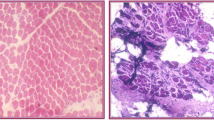Abstract
Severe neonatal centronuclear myopathy is inherited as an X-linked condition characterized by primary asphyxia, extreme muscular hypotonia and absent spontaneous movements. We report seven cases from three families to point out the importance of diagnosis with regard to prognosis, outcome and genetic counselling. In hypotonic diseases, analysis of cerebrospinal fluid, electromyography, nerve conduction velocity creatine kinase and a skin biopsy for fibroblast cultures for metabolic investigations are usually carried out. Needle muscle biopsy is an additional valuable investigation to establish diagnosis. In all our patients we found an increased number of centrally located nuclei with perinuclear halos confirming the diagnosis of centronuclear myopathy. The diagnosis of this disorder will become of greater importance as soon as carrier detection and prenatal diagnosis by DNA-technology are routinely available.
Similar content being viewed by others
References
Ambler MW, Neave C, Singer DB (1964) X-linked recessive myotubular myopathy: II. Muscle morphology and human myogenesis. Hum Pathol 15:1107–1120
Barth PG, Vijngaarden GK van, Bethlem J (1975) X-linked myotubular myopathy with fetal neonatal asphyxia. Neurology 25:531–536
Bruyland M, Liebaers I, Sacre L, Vandeplas Y, De Meirleir L, Martin JJ (1984) Neonatal myotubular myopathy with a probable X-linked inheritance: observations on a new family with a review of the literature. J Neurol 231:220–222
Bucher HU, Boltshauser E, Briner J, Gnehm HE, Jancer RC (1986) Severe neonatal centronuclear (myotubular) myopathy: an X-linked recessive disorder. Helv Paediatr Acta 41:291–300
Dubowitz V (1978) Muscle disorders in childhood. WB Saunders Company Ltd, London, pp 223–231
Hanefeld F (1986) Neuromuskuläre Erkrankungen als Ursache neonataler Atemstörungen. In: Moderne Intensivmedizin bei Kindern. Zuckschwerdt, München
Heckmatt JZ, Moosa A, Hutson C, Maunder-Sewry CA, Dubowitz V (1984) Diagnostic needle muscle biopsy. Arch Dis Child 59:528–532
Keppen LD, Hussian M, Woody B (1986) X-linked myotubular myopathy with intrafamilial variability and normal muscle biopsy in a definite female carrier. Am J Med Genet 25:723–724
Silver MM, Gilbert JJ, Steward S, Brabyn D, Jung J (1986) Morphologic and myometric analysis of muscle in X-linked myotubular myopathy. Hum Pathol 17:1167–1178
Wijngarden GK, Fleury P, Bethlem J, Meijer AEFH (1969) Familial “myotubular” myopathy. Neurology 19:901–908
Williams H, Sarafarazi M, Roberts K, Thomas NST, Cole G, Liechti-Gallati S, Harper PS (1987) X-linked myotubular myopathy (XLMTM): another muscle disease gene localized to Xq28 (Abstract). Am J Hum Genet 41:A110
Author information
Authors and Affiliations
Rights and permissions
About this article
Cite this article
Braga, S.E., Gerber, A., Meier, C. et al. Severe neonatal asphyxia due to X-linked centronuclear myopathy. Eur J Pediatr 150, 132–135 (1990). https://doi.org/10.1007/BF02072056
Received:
Accepted:
Issue Date:
DOI: https://doi.org/10.1007/BF02072056




